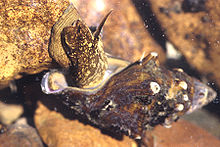Spiny river snail
| Spiny river snail | |
|---|---|

| |
| A live individual of Io fluvialis | |

| |
| A live individual of Io fluvialis | |
| Scientific classification | |
| Domain: | Eukaryota |
| Kingdom: | Animalia |
| Phylum: | Mollusca |
| Class: | Gastropoda |
| Subclass: | Caenogastropoda |
| Superfamily: | Cerithioidea |
| Family: | Pleuroceridae |
| Genus: | Io Lea, 1831[2] |
| Species: | I. fluvialis
|
| Binomial name | |
| Io fluvialis (Say, 1825)
| |
The spiny river snail, scientific name Io fluvialis, is a species of freshwater snail, an aquatic mollusk in the family Pleuroceridae. This is the only species in the genus Io.[3] This species is endemic to the USA.
Ecology
[edit]Distribution
[edit]This species is endemic to the Tennessee River and its larger tributaries, but it has been largely extirpated due to pollution and the construction of dams.
Habitat
[edit]These snails live in rapidly flowing, well-oxygenated waters of shoals and riffles of rivers, but not in slack water below shoals. The preferred water depth for this species is up to 1.5 m.
Behavior
[edit]These snails feed on the algal coating on rocks. Females lay between 20-100 eggs, which begin to hatch after 15 days.
Description
[edit]The shell morphology is very variable, with some individuals totally lacking spines. For this reason it was formerly thought that many species existed within this genus.
Human relevance
[edit]The shells are found abundantly in shell middens along the rivers within its range, indicating they were exploited as a food source by Native American cultures. Additionally, this snail has served as the emblem for the American Malacological Society since 1960.[4]
References
[edit]- ^ Bogan, A.E.; Seddon, M.B.; et al. (Mollusc Specialist Group) (1996). "Io fluvialis". IUCN Red List of Threatened Species. 1996: e.T10838A3221607. doi:10.2305/IUCN.UK.1996.RLTS.T10838A3221607.en. Retrieved 15 November 2021.
- ^ Lea I. (1831). Trans. Amer. phil. Soc. (N.S.) 4(1): 122.
- ^ Holznagel E. W. & Lydeard Ch. (2000). "A Molecular Phylogeny of North American Pleuroceridae (Gastropoda: Cerithioidea) Based on Mitochondrial 16S rDNA Sequences". Journal of Molluscan Studies 66(2): 233-257. doi:10.1093/mollus/66.2.233, abstract
- ^ [1] [dead link]

